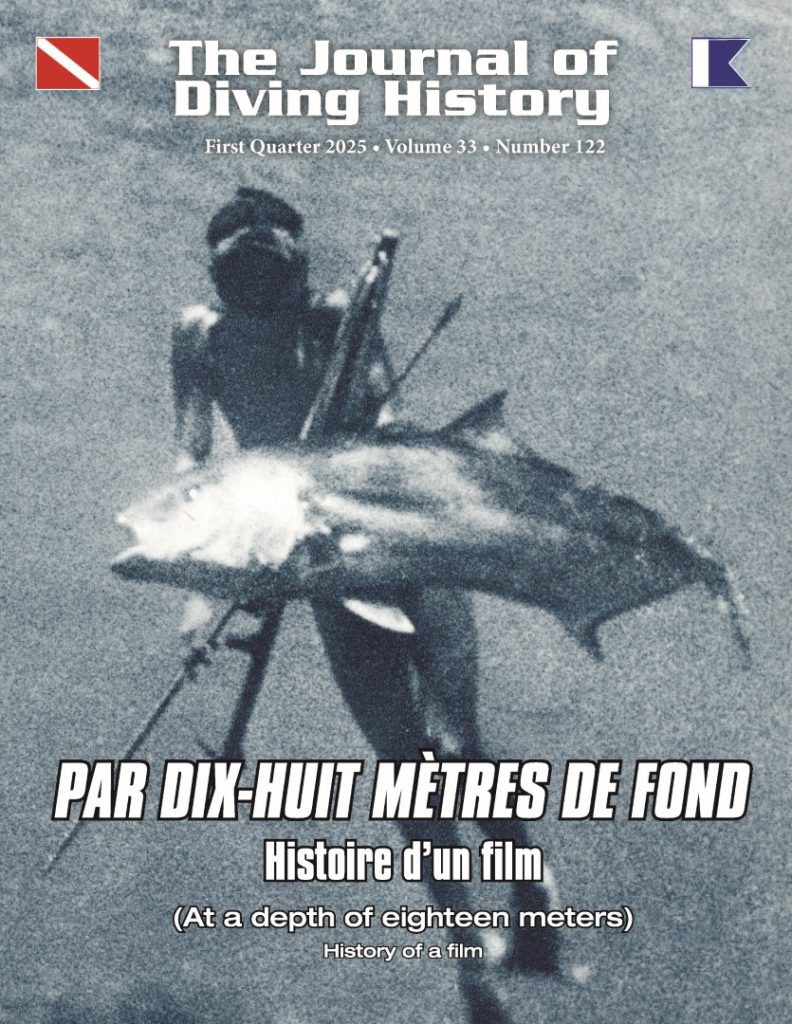Often times visitors to the dive museum comment on how they’ve never seen a dive museum before and how unusual the subject matter is, and wonder if it’s the only one? They aren’t far off, the ADHE is one of only a few in the nation. Most notably the Diving History Museum in the Florida Keys and a good colleague Ryan Spence’s Flashback Scuba Exhibit In Washington State. There are other online dive related museums but photos are not the same as walking into a room and seeing 3-D display items. The next typical question is why a dive museum? The obvious and quickest answer would be why not? But in truth the answer to that query is more complicated.
On January 23rd 1960 the Swiss designed, Italian built and American piloted Bathyscaph “Trieste” dove into history as she plunged into the very pit of the world’s deepest point in the Challenger Deep of the Mariana Trench near Guam in the South Pacific Ocean. The two men on board Trieste, Naval lieutenant and pilot Don Walsh along with Jacques Piccard also went down in history as the first human beings to venture into waters exerting 16,000 pounds of pressure on every square inch of surface area of their craft. But the man who was in charge of that mission, known as project Nekton was a Southern California native son. Thirty six year old Andreas (Andy) B. Rechnitzer who was the science officer in charge of the program and also who convinced the U.S. Navy and Congress to purchase the craft from the designer Auguste Piccard, father to Jacques.
When project Nekton was underway, Rechnitzer was already world renowned for co-authoring the syllabus by which dive instruction was modeled, the discovery of various undersea creatures including the sub tropical butterfly fish which is part of the Scripps oceanographic institutes logo design. Andy is the only person in history to have won the illustrious NOGI award, (the Oceanographic equivalent of an Oscar) three separate times. That measure alone depicts the incredible impact and influence Andy had on oceanography, Deep Submergence and scuba diving.
In 1994 I was part of a oceanic training mission in Key Largo, Florida called the “Scott Carpenter Man in the Sea” or “MITS” program which was largely based upon the U.S. Navy’s SEALAB I-III undersea laboratory experiments from the 1960’s.
My role was as lead submersible pilot instructor training students how to pilot a small research submarine. Other components of the program included living in undersea habitats, diving bell and hyperbaric chamber systems, and a host of high tech diving equipment all being taught by some pretty hefty ocean explorer names like Astronaut-Aquanaut Scott Carpenter, Naval Aquanaut Bob Barth, Tecktite Aquanaut Ian Koblick, oceanographer Dr. Sylvia Earle and one Andreas B. Rechnitzer..
It was through the MITS program where I would meet and work with all of these incredibly influential people. But it was Andy who decided to try to pour his knowledge and lifetime experiences into my head.
We quickly became friends and remained so until his passing in late summer of 2005. But prior to his passing Andy and I spent an entire decade downloading his experiences into my eager ears.
It was Andy who shared his bits of wisdom which helped direct my life and career. During one conversation he told me; “Keep collecting old dive gear because one day it’ll be impossible to find, and keep writing about diving history because if it isn’t written it never happened. That piece of inspiration got me to keep asking him more and more questions and his unselfish willingness to furnish answers along with his prodding and encouragement kept me pointed in the right direction.. later on I asked what my role could possibly be preserving dive history and he calmly replied; You’ve got a unique perspective having been part of it in some ways, but mostly you care about it.. you have a genuine and authentic interest in it.. remember, if not you, then who? If not now, then when? …. Andy Rechnitzer had a true talent of stating things in a very simplistic fashion. When Andy died in 2005 it was a loss which shook the diving world and crushed me personally. Andy was one of those rare and unbelievably unique individuals who mixed intellect, curiosity, humor, pioneering spirit and real adventure into one lifetime.. I was blessed and supremely fortunate to spend time with him. In 2017 the Avalon Diving History Exhibit opened its doors in the world famous Casino building next to the Casino point dive park.. a perfect location to celebrate and teach the public about the early pioneers in diving. On pace to reach 100k visitors in its third year, the ADHE is reaching people, many of them the young, the next generation who may be inspired to pick up the torch and carry it forward. I remember Andy sharing one of Mark Twain’s more notable quotes with me.. “The two most important days of your life are the day you are born, and the day you find out why”
For me, it’s doing what I can to help my community, share my experiences through teaching and try to make a positive difference along the way.

